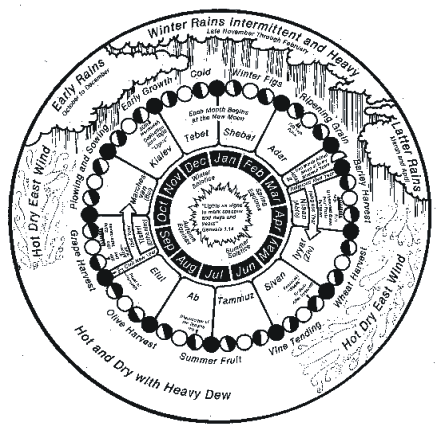
The Hebrew Calendar

The Hebrew calendar was regulated by four factors: sun, moon, the climate of the Promised Land, and the religious feasts commanded by God. Like other ancient peoples the Hebrews were aware of the solar year with its 365 1/4 days. Months, however, were marked off by the moon. A new month began whenever the horns of the waxing moon were first seen by the priests in Jerusalem. Since twelve lunar months do not make a full year, a thirteenth month was inserted every few years, usually after Adar or Elul. Priests tried to keep the months and seasons in step with each other so that the important festivals did not fall too early or too late. The names of the months used on the chart are those of the late Old Testament. There were borrowed from the Babylonians and are still in use today. In the days of Solomon the months were simply numbered (first month, second month, etc.). Only four of the earlier Hebrew names for the months are known. They are indicated on the chart in parenthesis.
The Promised Land has a Mediterranean type of climate with two principal seasons: (1) the summer with long, hot, dry days and dewy mornings, and (2) the winter with shorter, cooler days punctuated now and then by three or four days of continual downpour. Summer and winter are separated by short transitional periods in which the wind shifts to the east off the desert. Summer arrives regularly in mid-June. The beginning of the rainy season is not so predictable. It may begin with a shower in mid-October or delay as late as mid-December. Climate produces two harvest seasons, one in April-May and the other in September-October. These harvest seasons coincide with the opening and closing of the Hebrew calendar and with the principal feasts ordained by God through Moses. Passover and Pentecost embrace the grain harvest. Trumpets and Tabernacles with the Day of Atonement in between mark the fruit harvest. Passover falls on the full moon of the first month of the religious year. Trumpets opens the civil year. Purim, which falls in Adar, was added in the days of Esther. The Feast of Dedication (modern Hannakah) in Kislev was added to the calendar between the Old and New Testaments and is mentioned only in John 10:22.
Comments by John C. Lawrenz.
Note: This study was taken from “Bible History Commentary - Old Testament”, by Werner H. Franzmann; p. 578-579.
If you would like more information about this study,
please contact Pastor Mayhew